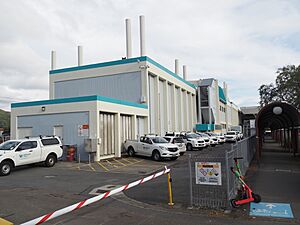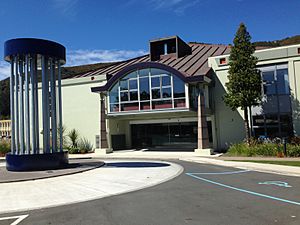Waterloo, New Zealand facts for kids
Quick facts for kids
Waterloo
|
|
|---|---|
|
Suburb
|
|

Waterloo Water Treatment Plant
|
|
| Country | New Zealand |
| Local authority | Lower Hutt |
| Electoral ward | Eastern Ward |
| Area | |
| • Land | 181 ha (447 acre) |
| Population
(June 2023)
|
|
| • Total | 5,800 |
| Train station(s) | Waterloo |
|
|
||
Waterloo is a suburb located in the eastern part of Lower Hutt, Wellington. It got its name from the famous Battle of Waterloo, which was won by the Duke of Wellington in 1815.
This suburb is home to Waterloo Primary School and the Open Polytechnic of New Zealand. It also has the Waterloo Interchange, which is a busy station for both trains and buses.
Contents
About Waterloo: People and Place
Waterloo covers an area of about 1.81 square kilometers. As of June 2023, it has an estimated population of 5800 people. This means there are about 3204 people living in each square kilometer.
Who Lives in Waterloo?
In 2018, Waterloo had a population of 5,379 people living in 2,013 homes. There were slightly more females than males. About one-fifth of the people were under 15 years old. Many adults were between 30 and 64 years old.
Waterloo is a diverse place. Most residents are of European background (70.2%). Other groups include Māori (10.2%), Pasifika (5.1%), and Asian (22.2%). About 29% of the people living here were born outside New Zealand.
Beliefs and Education in Waterloo
When asked about their beliefs, nearly half of the people (48.2%) said they had no religion. Many others were Christian (37.1%). Smaller groups followed Hinduism, Islam, Buddhism, or other beliefs.
Many adults in Waterloo have a good education. About 32.7% of people aged 15 and older had a university degree or higher. Most people were employed, working full-time or part-time.
Learning in Waterloo
Waterloo has its own primary school, called Waterloo School. It is a state school for students from Year 1 to Year 6. As of February 2024, the school has 482 students.
The Open Polytechnic of New Zealand is also located in Waterloo. This polytechnic is part of Te Pūkenga, which is a large organization for vocational education in New Zealand.
The Waiwhetū Stream: A Story of Cleanup
The Waiwhetū Stream is a small waterway that flows through Waterloo. It helps drain the eastern side of the Hutt Valley and eventually flows into Wellington Harbour.
For many years, as the Hutt Valley grew, the stream became very polluted. Factories and city development caused a lot of waste to enter the water. Some parts of the stream were even put into concrete tunnels to try and stop flooding. By 2010, it was known as one of the most polluted waterways in New Zealand.
Cleaning Up the Stream
Starting around 2003, people in the community pushed for the stream to be cleaned up. This led to a big project that finished in June 2010. During this project, 56,000 tonnes of harmful waste were removed from the lower parts of the stream.
After this, a community group was formed in 2010-2011 to help restore the upper parts of the stream. For 10 years, volunteers worked hard. They removed unwanted water plants and rubbish from about 6 kilometers of the stream bed. They also planted around 34,000 native plants along the stream banks. This effort helped bring the stream back to life.



